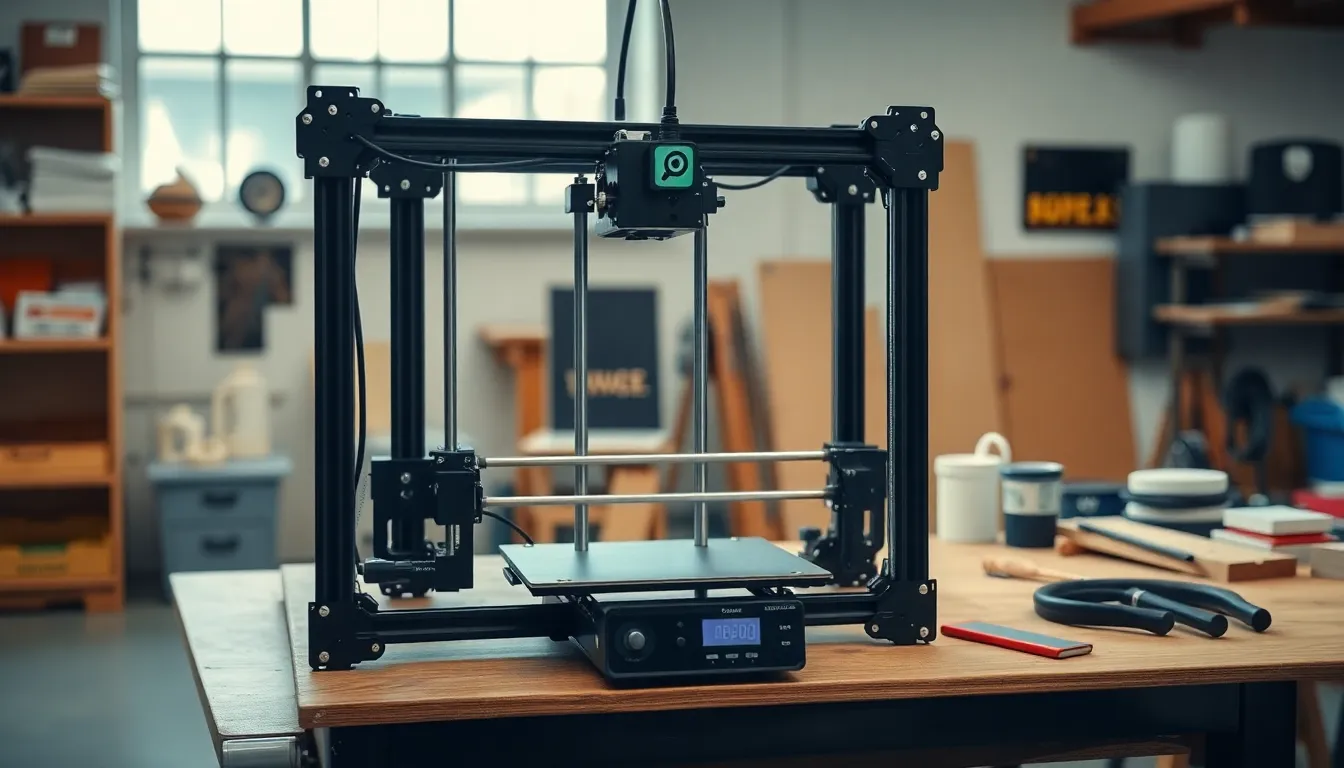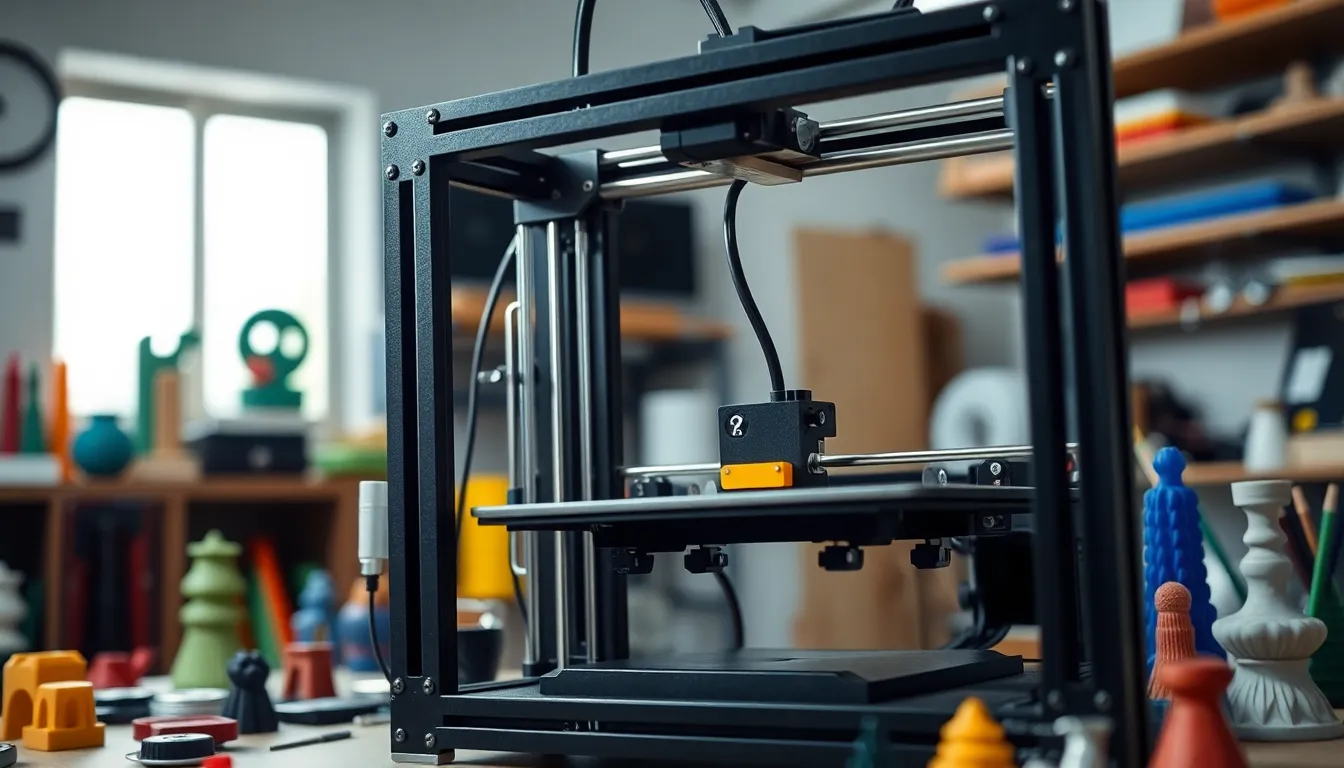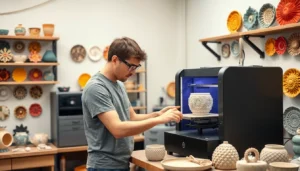Table of Contents
ToggleIn a world where creativity knows no bounds, 3D printers have emerged as the superheroes of the tech realm. They’re not just machines; they’re the magical wands that transform digital dreams into tangible reality. Imagine crafting everything from custom phone cases to intricate jewelry—all without breaking a sweat. But hold on, before diving into the fantastical world of 3D printing, one must first understand the hardware that makes this sorcery possible.
Choosing the right 3D printer hardware can feel like searching for the Holy Grail. With countless options and features, it’s easy to get lost in a sea of specs and jargon. Fear not! This guide will break down the essentials, making it easier to navigate the 3D printing landscape. So grab a cup of coffee, sit back, and prepare to unleash your inner inventor with the right tools at your fingertips.
Overview of 3D Printer Hardware
3D printer hardware consists of several essential components that work together to produce three-dimensional objects. The frame serves as the printer’s structure, ensuring stability during operation. Materials like aluminum and steel are common choices for durability.
The print head, or extruder, plays a critical role in melting and depositing filament layer by layer. It often includes a nozzle through which the material is extruded. Temperature control is vital for this component, affecting print quality and material flow.
The build platform provides a surface for the printed object. Heated platforms help prevent warping by maintaining optimal temperatures during printing. Various surfaces are available, including glass, aluminum, and PEI, each offering different adhesion properties.
Motion systems, including Cartesian, delta, and CoreXY, dictate how the print head and build platform move. Each system has unique advantages, like speed and accuracy, influencing project completion time and dimensional precision.
Power supplies offer the necessary energy to operate the printer, ensuring consistent performance. They must match the printer’s specifications for voltage and amperage to avoid damage.
Control boards represent the brain of the 3D printer. These boards manage the functions and coordinate movement, temperature regulation, and communication with connected devices. Popular options include Arduino-based controllers and proprietary systems from manufacturers.
Cooling systems are crucial for managing temperatures during and after printing. Heat sinks and fans prevent overheating, ensuring longevity and consistent performance.
By understanding these hardware components, users can make informed decisions when selecting or upgrading a 3D printer. Each component contributes to the overall performance and quality of the final printed objects.
Key Components of 3D Printers


Understanding key components of 3D printers is essential for achieving optimal results. Each part contributes significantly to the printer’s performance and the quality of the finished product.
Frame and Build Platform
The frame provides structural integrity and stability, preventing movement during printing. Materials such as aluminum and steel are common choices for durability. A strong frame ensures precise layer alignment, crucial for detailed prints. The build platform offers a surface for the object to adhere to during printing. Heated build platforms enhance adhesion and reduce warping, especially with thermoplastics. Users can select between glass, aluminum, or removable surfaces, depending on their printing needs.
Print Head and Extruder
The print head is responsible for melting filament and extruding it layer by layer. Accurate temperature control within the print head impacts material flow and print quality. Multiple nozzles allow for different filament sizes and types, contributing to versatility. An efficient extruder pushes filament consistently through the print head, ensuring precise deposition. Single or dual extrusion systems enhance the ability to print complex designs, enabling the use of multiple materials in one project.
Motion System
The motion system governs the printer’s movement along the X, Y, and Z axes. Cartesian systems use linear paths for straightforward, reliable printing, while delta systems utilize a unique arrangement for faster speeds and greater range of motion. CoreXY systems combine aspects of both, providing efficiency and precision. Smooth operation of the motion system impacts the overall accuracy and speed of printing. Users should evaluate the type of motion system based on their specific printing requirements.
Types of 3D Printer Hardware
Understanding different types of 3D printer hardware enhances informed decision-making for various printing needs. Each type offers unique features and advantages.
FDM Printers
Fused Deposition Modeling (FDM) printers dominate the consumer market, particularly for their affordability and simplicity. These machines operate by melting thermoplastic filaments and layering them to create objects. Users appreciate the extensive range of materials available, including PLA and ABS, which cater to different printing requirements. Maintenance remains straightforward, making FDM printers ideal for beginners. Speed is another benefit, allowing users to produce prototypes and models quickly. Popular options include the Creality Ender 3 and Prusa i3, both highly regarded for their performance and community support.
SLA Printers
Stereolithography (SLA) printers excel in producing high-resolution prints with excellent detail. They utilize a laser to cure liquid resin layer by layer, resulting in finer surfaces and intricacies. Designers and jewelers often favor SLA for its ability to create intricate designs and complex geometries. Users must manage resin handling and post-processing, which can be more demanding compared to FDM printing. However, the print quality often justifies the extra effort. Notable models include the Formlabs Form 3 and Anycubic Photon, recognized for their advanced technology and reliability.
SLS Printers
Selective Laser Sintering (SLS) printers utilize powdered materials, offering exceptional durability and strength. They sinter layers of powder using a high-powered laser, creating robust objects ideal for functional prototypes and end-use parts. Material options like nylon and metal make SLS a versatile choice for industrial applications. Users benefit from the absence of support structures, allowing for complex shapes and designs without compromise. Target industries include aerospace and automotive, making SLS printers like the EOS Formiga P110 and 3D Systems ProX SLS standout choices for professional settings.
Factors to Consider When Choosing 3D Printer Hardware
Selecting the right 3D printer hardware involves various factors that significantly influence the printing experience and final outcomes. Understanding these components helps users make informed decisions.
Print Quality
Print quality affects the overall effectiveness of a 3D printer. Resolution determines how finely detailed prints can be, measured in microns. Higher resolutions yield smoother surfaces and intricate details. Layer height impacts print quality; thinner layers create finer details. Filament type also plays a critical role. For example, PLA typically results in great detail, while ABS offers enhanced durability. Users should consider the specific applications and desired outcomes to select a printer that meets their print quality expectations.
Build Volume
Build volume defines the maximum size of printed objects. It significantly influences what projects can be completed. A larger build volume opens the door to producing bigger items or multiple smaller parts simultaneously. For hobbyists and professionals alike, ensuring the printer’s dimensions align with project requirements is essential. Common sizes range from compact models suitable for small objects to spacious ones designed for large prototypes. Evaluating the intended use helps in selecting an appropriate build volume for future creations.
Compatibility and Upgradability
Compatibility and upgradability are vital for a versatile printing experience. Selecting hardware that supports different filament types can enhance creative possibilities. It’s wise to check whether the printer allows for upgrades, such as improved extruders or additional nozzles. Some printers offer easy modifications, which can extend their lifespan and adapt to evolving needs. Users should also verify firmware updates, which can improve functionality over time. Ensuring the hardware is compatible with existing or future upgrades fosters longevity and adaptability in the 3D printing journey.






